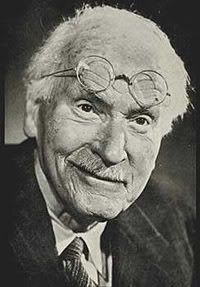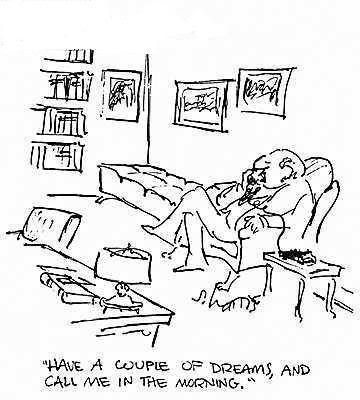 My leanings in academic pursuits, and my interest in mysticism inevitably led me to become acquainted with the ideas of Carl Jung. In the early 20th century, the world of psychoanalysis brought new dimensions to the understanding of fairy tales for the mainstream educated reading public. Freud and Jung -- especially Jung -- declared them to be phenomena arising from that "new" part of the mind they were telling the world about: the subconscious. (As an aside: the subconscious had been known and used as a tool for centuries by the esoteric schools. Buddhism understood it perfectly. Freud just gave it an acceptable "scientific" framework for working it into the Western paradigm.) This put fairy tales in close association with that other expression of the subconscious: dreams. As a matter of fact, Jung said that fairy tales were a product of the collective unconscious, which made them, more or less, the collective dreams of entire cultures, but in fairy tales the archetypes retain clearer, purer expression without the idiosyncratic complexes of individuals' dreams.
My leanings in academic pursuits, and my interest in mysticism inevitably led me to become acquainted with the ideas of Carl Jung. In the early 20th century, the world of psychoanalysis brought new dimensions to the understanding of fairy tales for the mainstream educated reading public. Freud and Jung -- especially Jung -- declared them to be phenomena arising from that "new" part of the mind they were telling the world about: the subconscious. (As an aside: the subconscious had been known and used as a tool for centuries by the esoteric schools. Buddhism understood it perfectly. Freud just gave it an acceptable "scientific" framework for working it into the Western paradigm.) This put fairy tales in close association with that other expression of the subconscious: dreams. As a matter of fact, Jung said that fairy tales were a product of the collective unconscious, which made them, more or less, the collective dreams of entire cultures, but in fairy tales the archetypes retain clearer, purer expression without the idiosyncratic complexes of individuals' dreams.On the one hand, it is quite liberating to look at fairy tales as the workings of the human race's collective mind, since it moves beyond a materialist, empirical preoccupation with ethnic, geographical and linguistic origins (i.e. Someone, somewhere thought this story up, and it's been passed on across time and space ever since.) Jung says that fairy tales come from within us: they are an expression of a very deep part of our being.
But on the other hand, as interesting an exercise as Jungian analysis of fairy tales can be (identifying the roles played in them by such archetypes as "The Old Man" who always appears at difficult junctures in the hero's quest, or the talking animals who advise the hero), for an esoteric student, there is something dissatisfying about the fact that it remains psychology. What's this supposed to do for non-psychologists? True, one can use the Jungian system as a framework for aesthetic criticism (of literature, visual art, cinema, etc.), but the question still remains: what does this mean to my quest? It's fine to know what these stories "mean" in some abstract sense, but what are we supposed to do with that knowledge?

9 comments:
You might be interested in The Third Eve, http://eve3.wordpress.com/. She has a PhD in Jungian psychology, but writes about many things. She's on a bit of hiatus right now, but her posts are fascinating.
I have always felt that the idea of fairy tales and other stories being sourced in the collective unconscious to be a somehow "right" idea for me. It just makes sense to me, and confirms my feelings about their importance and "trueness".
I think you could use the Jungian framework to examine stories or dreams without making it overly psychoanalytical. Perhaps you might dream of an Old Man figure, and go on to examine what meaning that kind of figure has for your life and esoteric quest right now. How does your personal flavor of esotericism speak about fairy tales? Can archetypes inform that?
There's a very good book about "Humanisztikus asztrológia", (unfortunately, it's Hungarian written by Rákos Péter, it might have an English edition too (but I doubt it :S) and it has a chapter on the archaic principles (planets) in fairy tales. It's surprisingly simple but complete at the same time...
Very-very interesting :)
henitsirk: I'll tell you what gets to me about psychology. Because of its history and legacy, it always seems you're always just a step away from talking about pathology. Everyone is sick. Everyone needs to be healed. Everything is a neurosis or a psychosis. If you're going to talk about your inner life, you're on the couch. I prefer to think of things as natural processes. The trials we go through and the tasks we undertake are a natural part of the evolution of humanity.
I'm cool with archetypes, but we have to remember that Jung didn't invent them. The theory of archetypes is just a usable model for explaining how symbols work within the subconscious. There are forces in the universe we are capable of perceiving through the non-material aspects of our being, but in order for them to become sensible to our conscious mind, the subconscious has to assign a symbol to it. There's where lots of people miss the point. The symbol is not the archetype. The symbol is the clothing, the vehicle of the archetype. Again, this was a concept that mystics of all ages have understood. Psychology only created a scientific language for talking about these things.
Obviously, if a dragon appears in a dream or a fairy tale, you are looking at a symbol embodying a very ancient force, as opposed to a tadpole, which would embody something new and rapidly changing.
I still want to play my cards close to the chest, though, and not give away the contents of the later postings.
Vero: I have a friend who's into humanistic psychology. Maybe she has the book. I imagine that interpreting fairy tales astrologically is similar to the what I referred to in my first posting as interpretting them pseudo-kaballistically.
Yep, pathologizing everything isn't very useful to me, either. And yes, archetypes are not equal to their symbols. I think Jungian concepts are useful for working with our personal imagery and experience, but always remembering that these are just symbols for more universal things. Also there are many layers of meaning for each symbol. (I just read some of the His Dark Materials books again, so I'm thinking of the alethiometer.) A dragon might mean ancient power, or materialism, or royal power, or subterranean/subconscious wisdom.
I used to be very interested in pagan/Wiccan animal symbols and totems. Certainly there were common "meanings" for each animal, but there were ranges of interpretations. So for me it's a balance between the archetypal truth and the personal truth.
Just for everyone's information, I deleted the previous post because someone slipped in here and commented for no other reason than to promote their commerical website. Where did I put the garlic, crucifixes and pointy wooden stakes?
I wouldn't call astrology pseudo- anything, although I know it is considered pseudoscience by the scientific community, but whatever. :S
What the book says is basically the Hermetic "as above, so below".
I give you an example: the witches (Saturn) are usually old, wrinkled, live lonely, have reptiles (cold) and bats. They have magic and typicaly "hurt" the "skin" (see sleeping beauty). Skin is Saturn. They wear black. Black is Saturn. Sleeping beauty sleeps for "a long time" typical Saturn. Restriction in this tale is also represented by the sleeping "staff" of the castle. They cannot move therefore cannot act. The prince has to get through the bushes with the thorns (that hurts the SKIN!!) and so on and so forth. It's very interesting to realise just how precisely they fit into the planets' principles. "As above, so below".
:)
Vero: Oh no! I didn't mean to suggest that astrology was pseudo-anything! I was calling my interpretation of fairy tales in my late teens and early twenties pseudo-kaballistic (as in: I think I was kind of sloppy, and I'm not so sure I knew what the hell I was doing).
Yes. I can see how using planetary keys would work.
:))
***
Yes, and it's just the surface. Itgets more complicated with the roles and interactions. ;)
Post a Comment